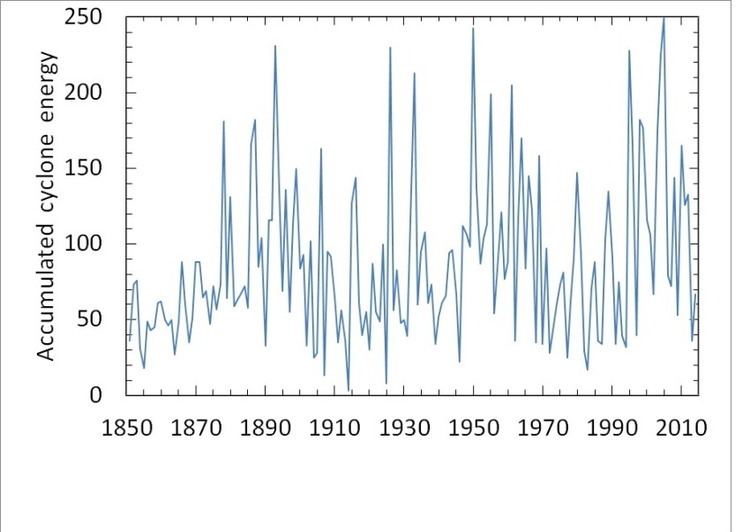 | ||
Accumulated cyclone energy (ACE) is a measure used by the National Oceanic and Atmospheric Administration (NOAA) to express the activity of individual tropical cyclones and entire tropical cyclone seasons, particularly the North Atlantic hurricane season. It uses an approximation of the wind energy used by a tropical system over its lifetime and is calculated every six-hour period. The ACE of a season is the sum of the ACEs for each storm and takes into account the number, strength, and duration of all the tropical storms in the season. In recorded history, the highest ACE worldwide for a single storm is 82, for Hurricane Ioke in 2006.
Contents
Calculation
The ACE of a season is calculated by summing the squares of the estimated maximum sustained velocity of every active tropical storm (wind speed 35 knots (65 km/h) or higher), at six-hour intervals. Since the calculation is sensitive to the starting point of the six-hour intervals, the convention is to use 0000, 0600, 1200, and 1800 UTC. If any storms of a season happen to cross years, the storm's ACE counts for the previous year. The numbers are usually divided by 10,000 to make them more manageable. The unit of ACE is 104 kn2, and for use as an index the unit is assumed. Thus:
where vmax is estimated sustained wind speed in knots.
Kinetic energy is proportional to the square of velocity, and by adding together the energy per some interval of time, the accumulated energy is found. As the duration of a storm increases, more values are summed and the ACE also increases such that longer-duration storms may accumulate a larger ACE than more-powerful storms of lesser duration. Although ACE is a value proportional to the energy of the system, it is not a direct calculation of energy (the mass of the moved air and therefore the size of the storm would show up in a real energy calculation).
A related quantity is hurricane destruction potential (HDP), which is ACE but only calculated for the time where the system is a hurricane.
Competing measurement metrics
ACE focuses upon the most intense winds concentrated in a storm's center. Whereas, the actual destructive power of a storm depends upon the total area impacted with damaging winds, waves, and storm surge. The metric Integrated Kinetic Energy (IKE), developed in 2007, more accurately reflects the destructive potential. It examines the kinetic energy that forces a storm surge and creates high waves as well as the horizontal wind loads over the full storm. This metric yields a time specific value for a storm and doesn't account for the destruction caused by a storm over its entire life. Therefore, in 2013 the researchers at the University of Florida created a metric called Track Integrated Kinetic Energy (TIKE). TIKE expands the concept by accumulating IKE over the lifespan of an individual tropical cyclone and a total value for all named tropical cyclones in the season.
Categories
A season's ACE is used by NOAA and others to categorize the hurricane season into 3 groups by its activity. Measured over the period 1951–2000 for the Atlantic basin, the median annual index was 87.5 and the mean annual index was 93.2. The NOAA categorization system divides seasons into:
According to the NOAA categorization system for the Atlantic, the most recent above-normal season is the 2016 season, the most recent near-normal season is the 2014 season, and the most recent below normal season is the 2015 season.
The term hyperactive is used by Goldenberg et al. (2001) based on a different weighting algorithm which places more weight on major hurricanes, but typically equating to an ACE of about 153 (175% of the 1951–2000 median).
Individual storms
The highest ever ACE estimated for a single storm in the Atlantic is 73.6, for Hurricane San Ciriaco in 1899. This single storm had an ACE higher than many whole Atlantic storm seasons. Other Atlantic storms with high ACEs include Hurricane Ivan in 2004, with an ACE of 70.4, Hurricane Donna in 1960, with an ACE of 64.6, Hurricane Isabel in 2003 with an ACE of 63.28, and the Great Charleston Hurricane of 1893 with an ACE of 63.5.
The following table shows those storms in the Atlantic basin from 1950-2016 that have had the highest ACE.
The highest ACE of a Category 1 hurricane was Hurricane Nadine of 2012, which attained an ACE of 26.3. The highest ACE of a tropical storm was Tropical Storm Alice of 1953, which attained an ACE of 9.6. The lowest ACE of any hurricane was Hurricane Three of 1959, which was only active for one day and had an ACE of just 1.2. The lowest ACE of a major hurricane was 1960's Hurricane Ethel and 1969's Hurricane Gerda, each with an ACE of 5.3.
Atlantic hurricane seasons, 1950–2016
For the current season or the season that just ended, the ACE is preliminary based on National Hurricane Center bulletins, which may later be revised.
East Pacific ACE
Accumulated Cyclone Energy is also used in the eastern and central Pacific Ocean. Data on ACE is considered reliable starting with the 1971 season. The season with the highest ACE since 1971 is the 1992 season. The 1977 season has the lowest ACE. The most recent above-normal season is the 2016 season, the most recent near-normal season is the 2012 season, and the most recent below normal season is the 2013 season. The 35 year median 1971–2005 is 115 x 104kn2 (100 in the EPAC zone east of 140°W, 13 in the CPAC zone); the mean is 130 (112 + 18).
The (unofficial) categorization of seasons for this table is based mutatis mutandis on that used in the Atlantic basin:
